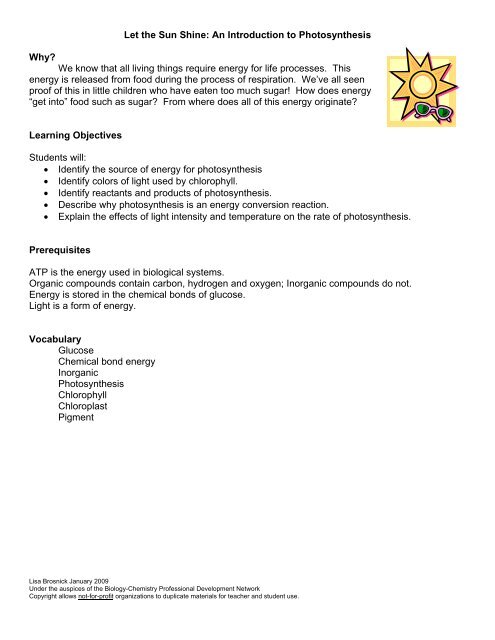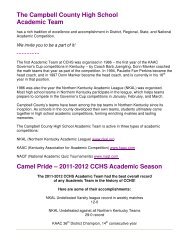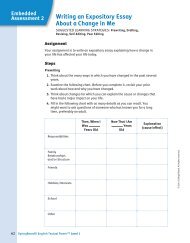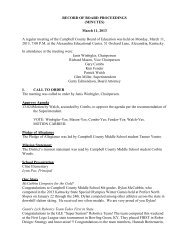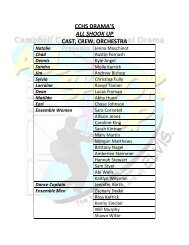Intro Photosynthesis-POGIL - Campbell County Schools
Intro Photosynthesis-POGIL - Campbell County Schools
Intro Photosynthesis-POGIL - Campbell County Schools
You also want an ePaper? Increase the reach of your titles
YUMPU automatically turns print PDFs into web optimized ePapers that Google loves.
Let the Sun Shine: An <strong>Intro</strong>duction to <strong>Photosynthesis</strong><br />
Why?<br />
We know that all living things require energy for life processes. This<br />
energy is released from food during the process of respiration. We’ve all seen<br />
proof of this in little children who have eaten too much sugar! How does energy<br />
“get into” food such as sugar? From where does all of this energy originate?<br />
Learning Objectives<br />
Students will:<br />
• Identify the source of energy for photosynthesis<br />
• Identify colors of light used by chlorophyll.<br />
• Identify reactants and products of photosynthesis.<br />
• Describe why photosynthesis is an energy conversion reaction.<br />
• Explain the effects of light intensity and temperature on the rate of photosynthesis.<br />
Prerequisites<br />
ATP is the energy used in biological systems.<br />
Organic compounds contain carbon, hydrogen and oxygen; Inorganic compounds do not.<br />
Energy is stored in the chemical bonds of glucose.<br />
Light is a form of energy.<br />
Vocabulary<br />
Glucose<br />
Chemical bond energy<br />
Inorganic<br />
<strong>Photosynthesis</strong><br />
Chlorophyll<br />
Chloroplast<br />
Pigment<br />
Lisa Brosnick January 2009<br />
Under the auspices of the Biology-Chemistry Professional Development Network<br />
Copyright allows not-for-profit organizations to duplicate materials for teacher and student use.
Model 1<br />
Figure 1: Electromagnetic Spectrum<br />
Figure 2: Action Spectrum for Chlorophyll<br />
Key Questions:<br />
1. What color of light has a wavelength of 700nm?<br />
2. At what two wavelengths does chlorophyll “a” absorb light the best?<br />
3. What two colors of light are used best by chlorophyll “a”?<br />
4. What color of light does chlorophyll “a” not use at all?<br />
5. In what organelle would you find chlorophyll?<br />
6. Pigments are defined as substances that interact with light to absorb only certain wavelengths.<br />
Explain why you think chlorophyll should be considered a pigment.<br />
7. Many plants contain pigments other than chlorophyll. What do you think is their purpose?<br />
Lisa Brosnick January 2009<br />
Under the auspices of the Biology-Chemistry Professional Development Network<br />
Copyright allows not-for-profit organizations to duplicate materials for teacher and student use.
Model 2<br />
Figure 3: Equation for <strong>Photosynthesis</strong><br />
H 2 O + CO 2 C 6 H 12 O 6 + O 2<br />
chlorophyll<br />
Key Questions:<br />
1. What two products are made during the photosynthesis reaction?<br />
2. What two inorganic molecules are used to make glucose?<br />
3. What is the purpose of chlorophyll in this equation?<br />
4. In what organelle would the above reaction occur?<br />
5. Where does the energy come from to run this reaction? Explain how you know this based on<br />
the equation.<br />
6. Explain why you think photosynthesis is considered an energy conversion reaction.<br />
7. Give examples of how both products of photosynthesis are important to other living things.<br />
Lisa Brosnick January 2009<br />
Under the auspices of the Biology-Chemistry Professional Development Network<br />
Copyright allows not-for-profit organizations to duplicate materials for teacher and student use.
Exercises<br />
1.<br />
2.<br />
Lisa Brosnick January 2009<br />
Under the auspices of the Biology-Chemistry Professional Development Network<br />
Copyright allows not-for-profit organizations to duplicate materials for teacher and student use.
3.<br />
Lisa Brosnick January 2009<br />
Under the auspices of the Biology-Chemistry Professional Development Network<br />
Copyright allows not-for-profit organizations to duplicate materials for teacher and student use.
4.<br />
a. What gas is being released by the plant?<br />
b. What high energy organic molecule is being made by<br />
this plant?<br />
c. What is the purpose of the green pigment in the<br />
chloroplast of the plant?<br />
Lisa Brosnick January 2009<br />
Under the auspices of the Biology-Chemistry Professional Development Network<br />
Copyright allows not-for-profit organizations to duplicate materials for teacher and student use.
Model 3<br />
fig.4 The effect of light intensity on rate of photosynthesis<br />
fig. 5 The effect of temperature on rate of photosynthesis<br />
Key Questions<br />
1. At what temperature(s) is/are the rate of photosynthesis the greatest?<br />
2. At what light intensity(s) is/are the rate of photosynthesis the greatest?<br />
3. Why is the rate of photosynthesis measured in units of oxygen production? Explain how you could<br />
use another molecule to determine rate of photosynthesis?<br />
4. Explain why you think photosynthesis happens at a slower rate when there is less light available.<br />
5. You want to set up a greenhouse. Based on these graphs, what conditions would help you grow<br />
the best plants? Explain your answer.<br />
6. Why do you think the two variables of light intensity and temperature have different effects on the<br />
rate of photosynthesis? In other words, why are the graphs different shapes?<br />
Lisa Brosnick January 2009<br />
Under the auspices of the Biology-Chemistry Professional Development Network<br />
Copyright allows not-for-profit organizations to duplicate materials for teacher and student use.
7. Based on the graphs, what parts(s) of the world would have the highest rates of photosynthetic<br />
activity? Explain your answer.<br />
Lisa Brosnick January 2009<br />
Under the auspices of the Biology-Chemistry Professional Development Network<br />
Copyright allows not-for-profit organizations to duplicate materials for teacher and student use.
Instructor’s Guide: Let the Sun Shine: An <strong>Intro</strong>duction to <strong>Photosynthesis</strong><br />
Standards Connections<br />
Connections to the National Science Education Standards:<br />
• The energy for life primarily derives from the sun. Plants capture energy by absorbing light<br />
and using it to form strong (covalent) chemical bonds between the atoms of carboncontaining<br />
(organic) molecules. In addition, the energy stored in bonds between the atoms<br />
(chemical energy) can be used as sources of energy for life processes.<br />
Connections to the New York State Living Environment Core Curriculum:<br />
• 5.1a The energy for life comes primarily from the sun. <strong>Photosynthesis</strong> provides a vital connection<br />
between the sun and the energy needs of living organisms.<br />
• 5.1b Plant cells and some one-celled organisms contain chloroplasts, the site of photosynthesis. The<br />
process of photosynthesis uses solar energy to combine the inorganic molecules carbon dioxide and<br />
water into energy-rich organic compounds (e.g., glucose) and release oxygen into the environment.<br />
Hints For Facilitation<br />
Model 1 #3: Remind students that the question is looking for “colors” not wavelength. It is OK for students to<br />
give a color range.<br />
Model 1 #4: It is appropriate for students to give a range of color for this question.<br />
Model 2 #5: This question requires that students make a connection between Model 1 and Model 2. Teachers<br />
may have to lead students to the answer by first directing students to the word chlorophyll in the equation and<br />
then reminding them that pigments absorb light energy.<br />
Model 3 #6 Teachers may have to remind students about the role of enzymes in this reaction and how<br />
temperature affects enzymes.<br />
Model 3 #7 Teachers need not worry about exact locations. It is only important that students pick a location<br />
with much light and warm temperature.<br />
Lisa Brosnick January 2009<br />
Under the auspices of the Biology-Chemistry Professional Development Network<br />
Copyright allows not-for-profit organizations to duplicate materials for teacher and student use.
Why?<br />
We know that all living things require energy for life processes. This energy is<br />
released from food during the process of respiration. We’ve all seen proof of this in little<br />
children who have eaten too much sugar! How does energy “get into” food such as<br />
sugar? From where does all of this energy originate?<br />
Learning Objectives<br />
Students will:<br />
• Identify the source of energy for photosynthesis<br />
• Identify colors of light used by chlorophyll.<br />
• Identify reactants and products of photosynthesis.<br />
• Describe why photosynthesis is an energy conversion reaction.<br />
• Explain the effects of light intensity and temperature on the rate of photosynthesis.<br />
Prerequisites<br />
ATP is the energy used in biological systems.<br />
Organic compounds contain carbon, hydrogen and oxygen; Inorganic compounds do not.<br />
Energy is stored in the chemical bonds of glucose.<br />
Light is a form of energy.<br />
Vocabulary<br />
Glucose<br />
Chemical bond energy<br />
Inorganic<br />
<strong>Photosynthesis</strong><br />
Chlorophyll<br />
Chloroplast<br />
Pigment<br />
Lisa Brosnick January 2009<br />
Under the auspices of the Biology-Chemistry Professional Development Network<br />
Copyright allows not-for-profit organizations to duplicate materials for teacher and student use.
Model 1<br />
Figure 1: Electromagnetic Spectrum<br />
Figure 2: Action Spectrum for Chlorophyll<br />
Key Questions:<br />
1. What color of light has a wavelength of 700nm?<br />
red<br />
2. At what two wavelengths does chlorophyll “a” absorb light the best?<br />
~675 nm and 425 nm<br />
3. What two colors of light are used best by chlorophyll “a”?<br />
red-orange and violet-blue<br />
4. What color of light does chlorophyll “a” not use at all?<br />
Green-yellow<br />
5. In what organelle would you find chlorophyll?<br />
chloroplast<br />
6. Pigments are defined as substances that interact with light to absorb only certain wavelengths. Explain<br />
why you think chlorophyll should be considered a pigment.<br />
When looking at the absorption spectrum graph, I can see that chlorophyll only absorbs light of<br />
certain wavelengths. This meets the criteria of the definition.<br />
7. Many plants contain pigments other than chlorophyll. What do you think is their purpose?<br />
Lisa Brosnick January 2009<br />
Under the auspices of the Biology-Chemistry Professional Development Network<br />
Copyright allows not-for-profit organizations to duplicate materials for teacher and student use.
Pigments other than chlorophyll might absorb light at other wavelengths or these pigments might<br />
absorb wavelengths that chlorophyll does not absorb.<br />
Model 2<br />
Figure 3: Equation for <strong>Photosynthesis</strong><br />
H 2 O + CO 2 C 6 H 12 O 6 + O 2<br />
chlorophyll<br />
Key Questions:<br />
1. What two products are made during the photosynthesis reaction?<br />
Glucose and oxygen<br />
2. What two inorganic molecules are used to make glucose?<br />
Water and carbon dioxide<br />
3. What is the purpose of chlorophyll in this equation?<br />
Chlorophyll is a pigment that absorbs light energy.<br />
4. In what organelle would the above reaction occur?<br />
chloroplast<br />
5. Where does the energy come from to run this reaction? Explain how you know this based on the<br />
equation.<br />
The energy must come from sunlight. Chlorophyll is seen in the equation to absorb light.<br />
6. Explain why you think photosynthesis is considered an energy conversion reaction.<br />
This is an energy conversion reaction because the energy in light is converted into chemical bind<br />
energy in glucose.<br />
7. Give examples of how both products of photosynthesis are important to other living things.<br />
Lisa Brosnick January 2009<br />
Under the auspices of the Biology-Chemistry Professional Development Network<br />
Copyright allows not-for-profit organizations to duplicate materials for teacher and student use.
The glucose is used for food, the oxygen is used for breathing or aerobic respiration.<br />
Exercises<br />
1.<br />
X<br />
2.<br />
X<br />
Lisa Brosnick January 2009<br />
Under the auspices of the Biology-Chemistry Professional Development Network<br />
Copyright allows not-for-profit organizations to duplicate materials for teacher and student use.
X<br />
3.<br />
Lisa Brosnick January 2009<br />
Under the auspices of the Biology-Chemistry Professional Development Network<br />
Copyright allows not-for-profit organizations to duplicate materials for teacher and student use.
X<br />
4.<br />
a. What gas is being released by the plant?<br />
Oxygen<br />
b. What high energy organic molecule is being made by this<br />
plant?<br />
Glucose<br />
c. What is the purpose of the green pigment in the chloroplast of<br />
the plant?<br />
To absorb light energy<br />
Lisa Brosnick January 2009<br />
Under the auspices of the Biology-Chemistry Professional Development Network<br />
Copyright allows not-for-profit organizations to duplicate materials for teacher and student use.
Model 3<br />
fig.4 The effect of light intensity on rate of photosynthesis<br />
fig. 5 The effect of temperature on rate of photosynthesis<br />
Key Questions<br />
1. At what temperature(s) is/are the rate of photosynthesis the greatest?<br />
~25ºC<br />
2. At what light intensity(s) is/are the rate of photosynthesis the greatest?<br />
Above 500 units<br />
3. Why is the rate of photosynthesis measured in units of oxygen production? Explain how you could use<br />
another molecule to determine rate of photosynthesis?<br />
Since oxygen is being produced during the reaction, we can measure how fate the reaction<br />
is happening by how much oxygen is produced per unit time. We could measure the rate of glucose<br />
production as well. Conversely, we could measure the uptake of carbon dioxide or water to measure the<br />
rate of photosynthesis.<br />
4. Explain why you think photosynthesis happens at a slower rate when there is less light available.<br />
Light provides energy for the reaction. The less light that is available, the energy available to run the<br />
reaction, the slower photosynthesis occurs.<br />
5. You want to set up a greenhouse. Based on these graphs, what conditions would help you grow the best<br />
plants? Explain your answer.<br />
My greenhouse would have to be around 25ºC since that is the optimum temperature and have a light<br />
intensity of about 500 units since photosynthesis happens best at these conditions.<br />
Lisa Brosnick January 2009<br />
Under the auspices of the Biology-Chemistry Professional Development Network<br />
Copyright allows not-for-profit organizations to duplicate materials for teacher and student use.
6. Why do you think the two variables of light intensity and temperature have different effects on the rate of<br />
photosynthesis? In other words, why are the graphs different shapes?<br />
Student answers will vary. However, students should be directed to the temperature curve and recognize<br />
that enzymes are affected by temperature. The input of light does not require enzymes and therefore will<br />
not dip when light intensity reaches optimum level.<br />
7. Based on the graphs, what parts(s) of the world would have the highest rates of photosynthetic activity?<br />
Explain your answer.<br />
Student answers will vary, but should show an understanding that warm temperatures and sufficient<br />
light are necessary.<br />
Lisa Brosnick January 2009<br />
Under the auspices of the Biology-Chemistry Professional Development Network<br />
Copyright allows not-for-profit organizations to duplicate materials for teacher and student use.


